Fig. 9‑7 shows the RT transfer rates, or fluxes, from the repository into the Malm aquifer above and into the Keuper and Muschelkalk aquifers below; these RT fluxes are assumed, in the analysis of radiological consequences, to be transferred directly to the biosphere. These transfer rates are compared with the following reference values, or “yardsticks”, which serve to place the transfer rates of RT from the repository in a broader perspective.
These yardsticks are based both on natural systems:
-
RT fluxes in two major rivers in Northern Switzerland, the Rhine in the vicinity of the city of Basel and the Thur,
and on human actions:
-
the RT of ash generated annually by the incineration of Swiss municipal waste.
The figure also shows the 60 Sv/a reference RT flux recommended in the EU SPIN project (Becker et al. 2002).
RT transfer rates to the biosphere via the three deep aquifers above and below the repository are orders of magnitude below all these yardsticks. They are, for example, three orders of magnitude or more below the SPIN reference value in the case of releases from HLW and five orders of magnitude or more below this reference value in the case of releases from L/ILW.
Fig. 9‑8 shows the reference case aqueous RT concentrations due to releases from the HLW canisters, with an anticipated breaching time of 10,000 years, and from L/ILW at various locations within the repository barrier system, namely:
-
the bentonite buffer, where the spatially averaged concentration is shown in the figure,
-
the L/ILW cementitious near field, where again the spatially averaged concentration is shown in the figure and
-
the lower boundary of the Opalinus Clay,
-
as well as in the Malm aquifer above the repository and in the Keuper and Muschelkalk aquifers below it.
These concentrations are compared with the RT concentrations found naturally in Swiss drinking water and in Swiss mineral water; see Tab. 9‑1 for information on these yardsticks and their sources. Fig. 9‑8 also shows the 2 × 10-5 Sv/m3 reference RT concentration recommended in the EU SPIN project, which is based on K-40, Rb-97 and actinide concentrations naturally present in surface and shallow groundwaters in Finland, Switzerland, and the Czech Republic.
Aqueous RT concentrations in both the HLW near field and the L/ILW near field remain orders of magnitude above these yardsticks for all calculated times, emphasising why the geological barrier is needed to isolate the waste from humans and the surface environment.
The dominant pathway for radionuclide transport through the Opalinus Clay in the reference case is downwards from the repository towards the Keuper aquifer; see Chapter 8 or, for more detail, Section 7.1.1.3 in NTB 24-18 (Nagra 2024p). After a few tens of thousands of years, the RT concentration due to radionuclide releases from HLW in porewater at the lower boundary of the Opalinus Clay is also above the various yardsticks, but by a much lower margin (one to three orders of magnitude) than the aqueous RT concentrations in the HLW near field. The RT concentration due to releases from L/ILW in porewater at the lower boundary of the Opalinus Clay peaks at about 200,000 years and is similar to the upper bound value for Swiss drinking water, and around an order of magnitude above the SPIN reference value.
Aqueous RT concentrations are further greatly reduced when radionuclides reach the Malm, Keuper and Muschelkalk aquifers, due to decay during transport through the confining geological units and dilution within the aquifers themselves. The aqueous RT concentration in the Malm and Keuper aquifers due to releases from HLW are within the ranges of RT concentrations found in Swiss drinking water and in Swiss mineral water. The maximum RT concentration in the Malm aquifer is about an order of magnitude above the SPIN reference value, and the maximum RT concentration in the Keuper aquifer is a little below this reference value. RT concentration in the Muschelkalk aquifer is much lower, remaining about three orders of magnitude below the SPIN reference value.
Tab. 9‑1:Descriptions, values and sources for the yardsticks presented in Fig. 9‑7 and in Fig. 9‑8
|
Yardstick |
Description/value |
Source |
|---|---|---|
|
Rhine/Thur Rivers: water + sediment |
RT flux due to radionuclides dissolved in water and due to radionuclides contained in sediments transported by the river; 3.5 × 105 Sv/a for the Rhine, 1.9 × 104 Sv/a for the Thur |
A3.5.1 in Nagra (2002) and references therein |
|
Rhine/Thur Rivers: water only |
RT flux due to radionuclides dissolved in water; 2.7 × 104 Sv/a for the Rhine, 42 Sv/a for the Thur |
|
|
Ash from municipal waste incineration |
Range of RT flux calculated for the whole of Switzerland; 4.7 × 103 Sv/a to 3.4 × 105 Sv/a |
Radiological composition of ash from municipal waste incineration based on minimum and maximum values reported in Kallio et al. (2023); per-capita waste production in Switzerland is based on the Federal Office of the Environment (available online at https://www.bfs.admin.ch/bfs/de/home/statistiken/raum-umwelt/umweltindikatoren/alle-indikatoren/emissionen-und abfaelle/siedlungsabfaelle.assetdetail.30645407.html); Size of Swiss population based on BFS (2022) |
|
Drinking water |
RT concentration in Swiss drinking water, ranging from 7.4 × 10-6 Sv/m3 to 3.4 × 10-4 Sv/m3 |
Radiological composition of drinking water based on Surbeck (2023) and on the Federal Office of Public Health (BAG 2023a) |
|
Consumption of mineral water |
RT concentration of mineral water, ranging from 1.1 × 10-5 Sv/m3 to 1.4 × 10-4 Sv/m3 |
Radiological composition of mineral water based on Baertschi (1995) |
|
SPIN reference value |
Based on several processes transferring naturally occurring radionuclides in the surface and subsurface environments, such as groundwater flow, weathering and erosion, and sediment transport, across an area of 200 km2; 60 Sv/a |
|
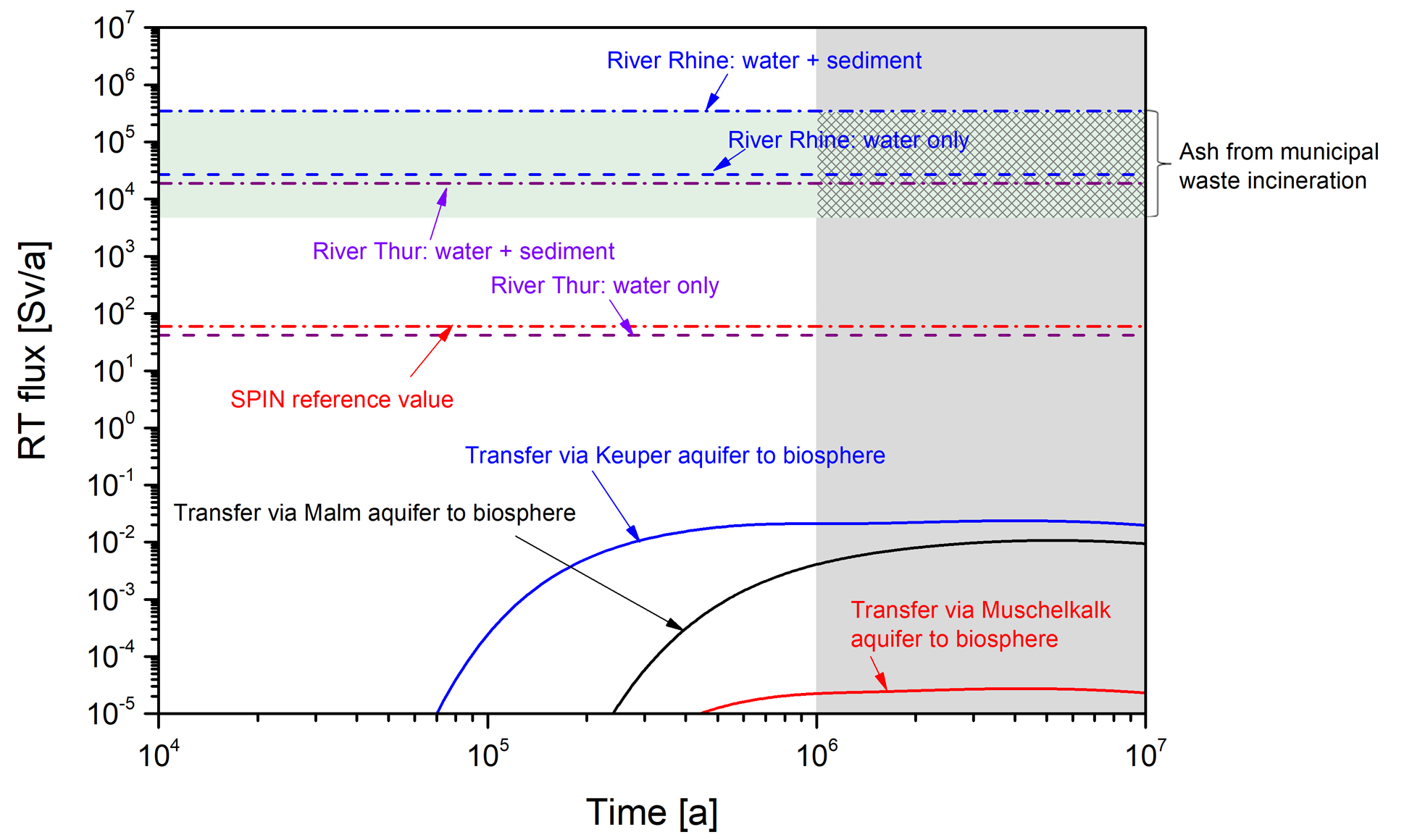
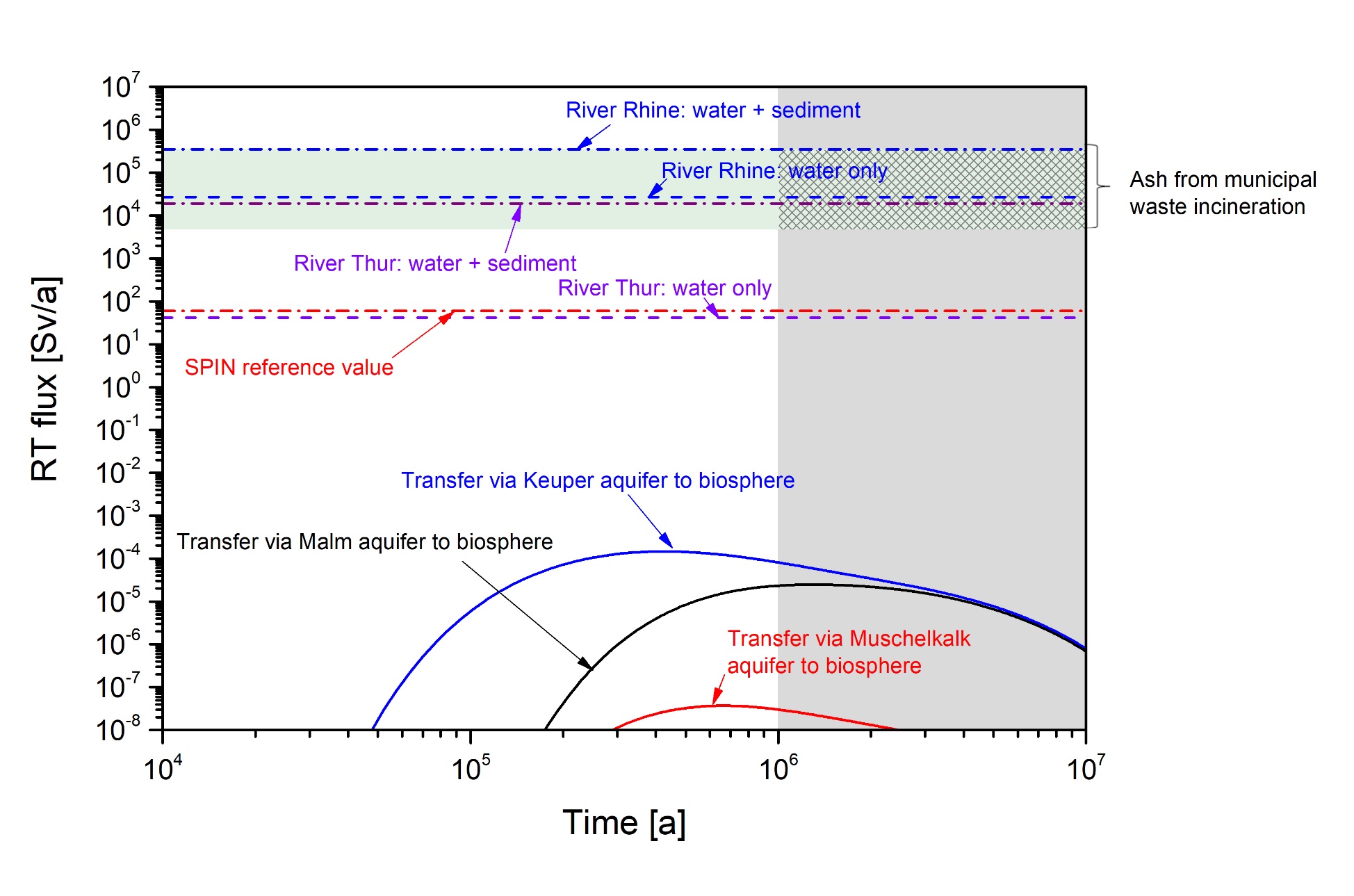
Fig. 9‑7:Reference case RT transfer rates (flux) from HLW (upper figure) and from L/ILW (lower figure) into the Malm aquifer located above the repository and into the Keuper and Muschelkalk aquifers lying below it
These fluxes are assumed, in the analysis of radiological consequences, to be further transferred directly to the biosphere. These transfer rates are compared with RT fluxes in two major rivers in Northern Switzerland, with RT fluxes from human activities, i.e., the consumption of water for drinking and the incineration of municipal waste and with a reference RT flux from the EU SPIN project.
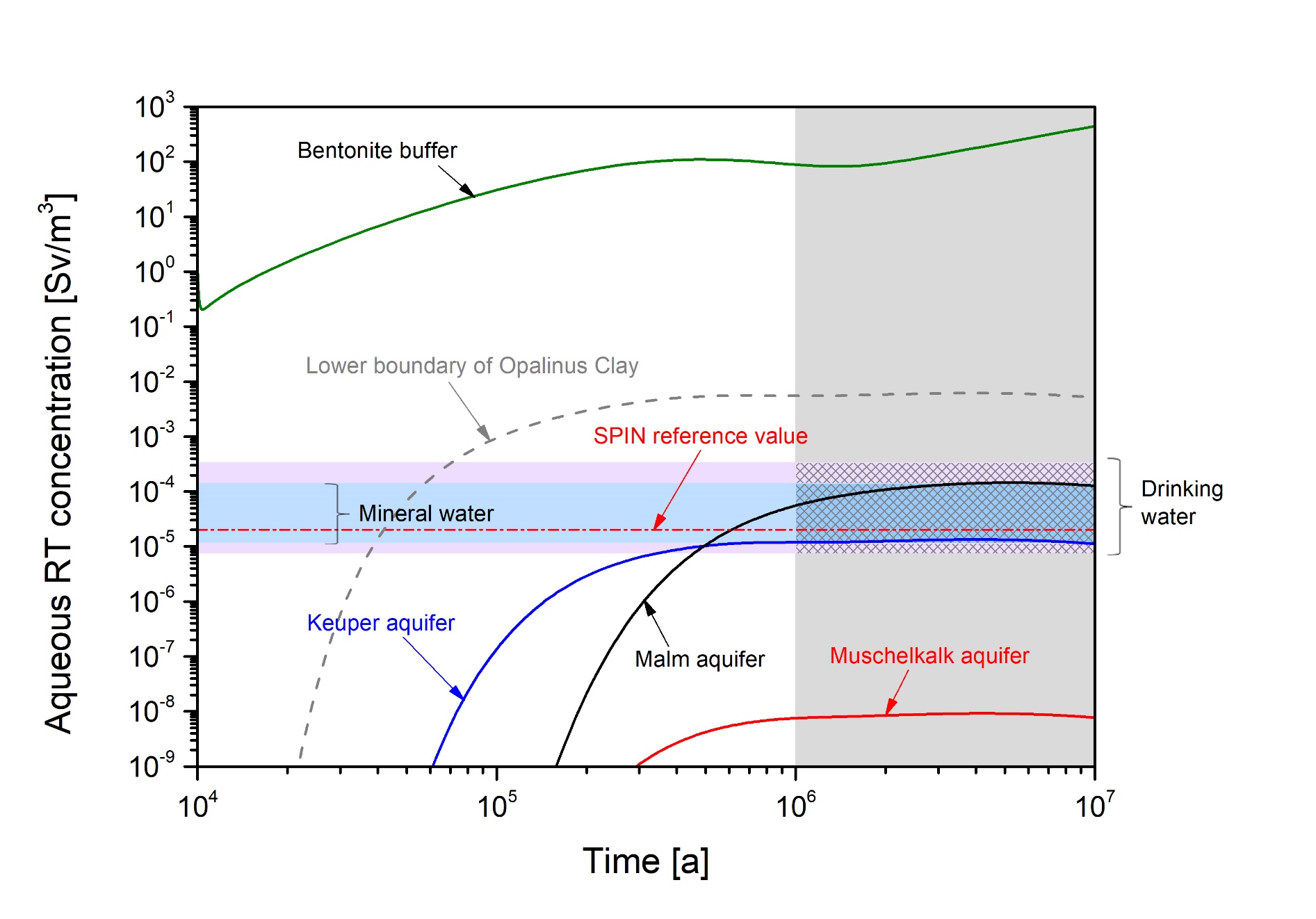
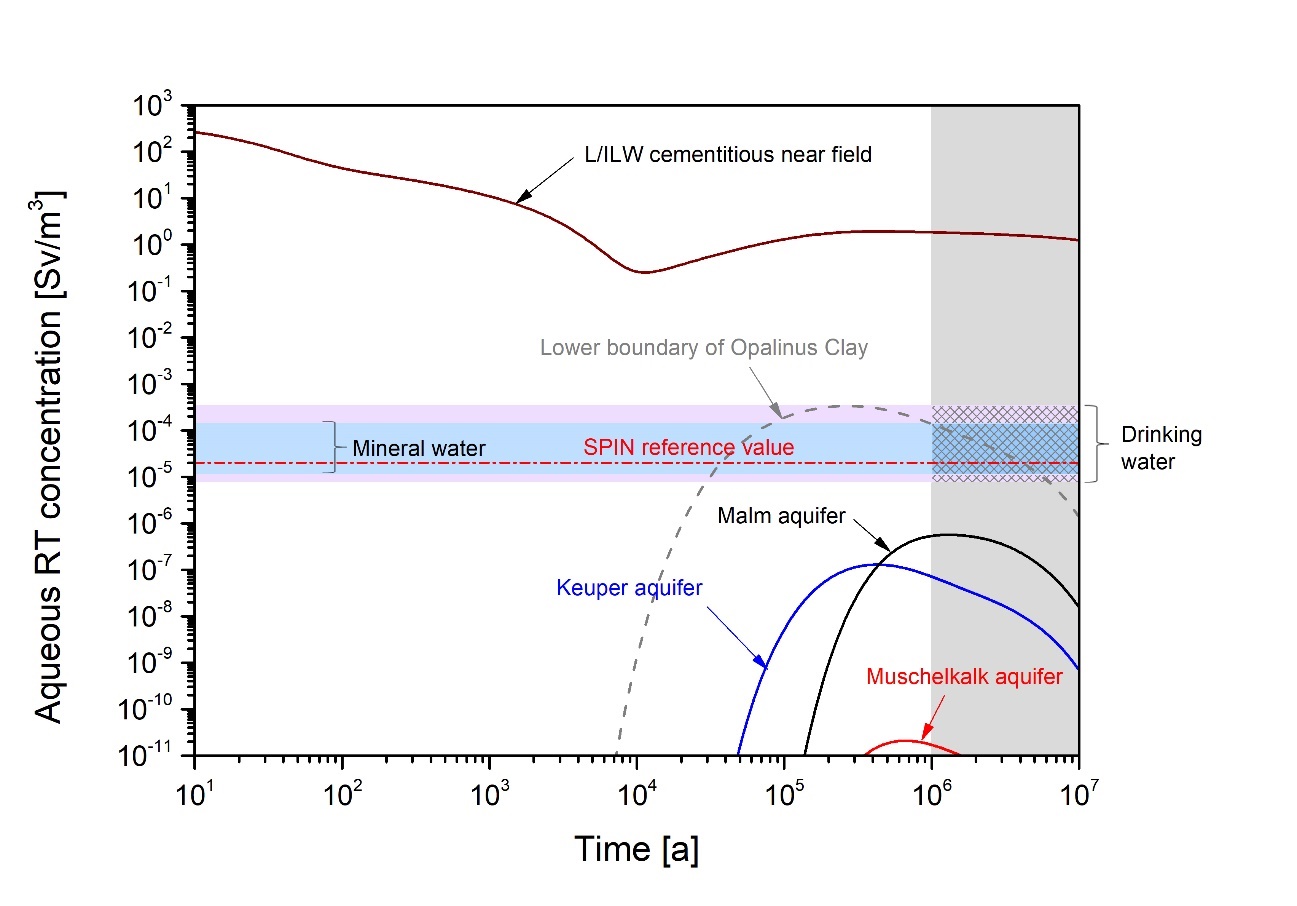
Fig. 9‑8:Reference case aqueous RT concentrations due to releases from HLW (upper figure) and from L/ILW (lower figure) at various locations within the repository barrier system, as well as in the Malm aquifer located above the repository and in the Keuper and Muschelkalk aquifers lying below it
These concentrations are compared with the RT concentrations found naturally in Swiss drinking water and in Swiss mineral water and with a reference RT concentration from the EU SPIN project. Note that the concentrations in the aquifers are obtained by dividing calculated RT fluxes from the rock to the aquifers by assumed aquifer flow rates across the repository area. These flow rates are subject to substantial uncertainty and are estimated here for illustrative purposes only.
The aqueous RT concentration in the deep aquifers due to releases from L/ILW are lower still and remain at least an order of magnitude below all the above-mentioned yardsticks.
Many radionuclides released from the repository sorb strongly on various barrier materials, retarding their transport and providing more time for radioactive decay. Fig. 9‑9 shows reference-case RT concentrations, due to both sorbed radionuclides and radionuclides present in the aqueous phase, in barrier materials within the repository system, namely:
-
the HLW bentonite buffer,
-
the L/ILW cementitious near field, and
-
the Opalinus Clay host rock.
In all three cases, spatially averaged concentrations are shown. For the Opalinus Clay host rock, this involves spatial averaging over the rock volume above and below the repository, up to the boundaries with the upper and lower confining geological units.
These concentrations are compared with the RT concentrations found naturally in various rocks, ores and average soil in Switzerland. The rock and ores used in this comparison are the same as considered in Section 9.2.1 in the context of the declining radiological hazard from the waste packages, i.e.:
-
Böttstein granite, a well-characterised, typical granite of Northern Switzerland,
-
uranium ore from the Cigar Lake deposit in northern Saskatchewan, Canada, with two different uranium concentrations, and
-
rock from La Creusaz, a small uranium deposit in canton Valais, Switzerland,
as well as the Opalinus Clay itself, as currently characterised, prior to any releases from the repository.
The RT concentrations in barrier materials within the repository system lie within the range spanned by these naturally occurring materials and are generally below the RT concentration in uranium ores.
RT concentrations in the near-field materials are generally above those found naturally in the Opalinus Clay, Böttstein granite and in Swiss soils. However, the RT concentrations in the Opalinus Clay due to releases from HLW and L/ILW are generally within the same range as found naturally in these materials. In the case of releases from HLW, the RT concentration in the Opalinus Clay increases over several millions of years, reaching a plateau value (once all the SF has degraded and released its radionuclides) that is between that of the Opalinus Clay and that of Böttstein granite. In the case of releases from L/ILW, the RT concentration in the Opalinus Clay peaks relatively rapidly, after just a few decades, at a value between that of the Opalinus Clay and the Böttstein granite, and declines gradually thereafter, reaching a value similar to that of average soil in Switzerland after about 10,000 years.
Overall, the comparisons shown in this section demonstrate that calculated RT transfer via deep aquifers to the biosphere is often much lower than the RT fluxes that currently occur in some natural systems (e.g., major rivers in Northern Switzerland), and much lower than those arising from some current human actions (waste incineration, consumption of drinking water and mineral water in Switzerland). RT concentrations, both aqueous and sorbed, are relatively high in the repository near field, but, in the host rock, they are similar to those occurring in many natural systems and materials. Furthermore, in the deep aquifer water that could potentially reach the biosphere, aqueous RT concentrations due to repository releases are well below the RT concentrations occurring in many natural systems and materials. Such comparisons can place the RT transfers due to the repository in a broader perspective, emphasising that radionuclide fluxes and concentrations that may arise due to the presence of the repository are often much lower than those that already exist in the human environment today.
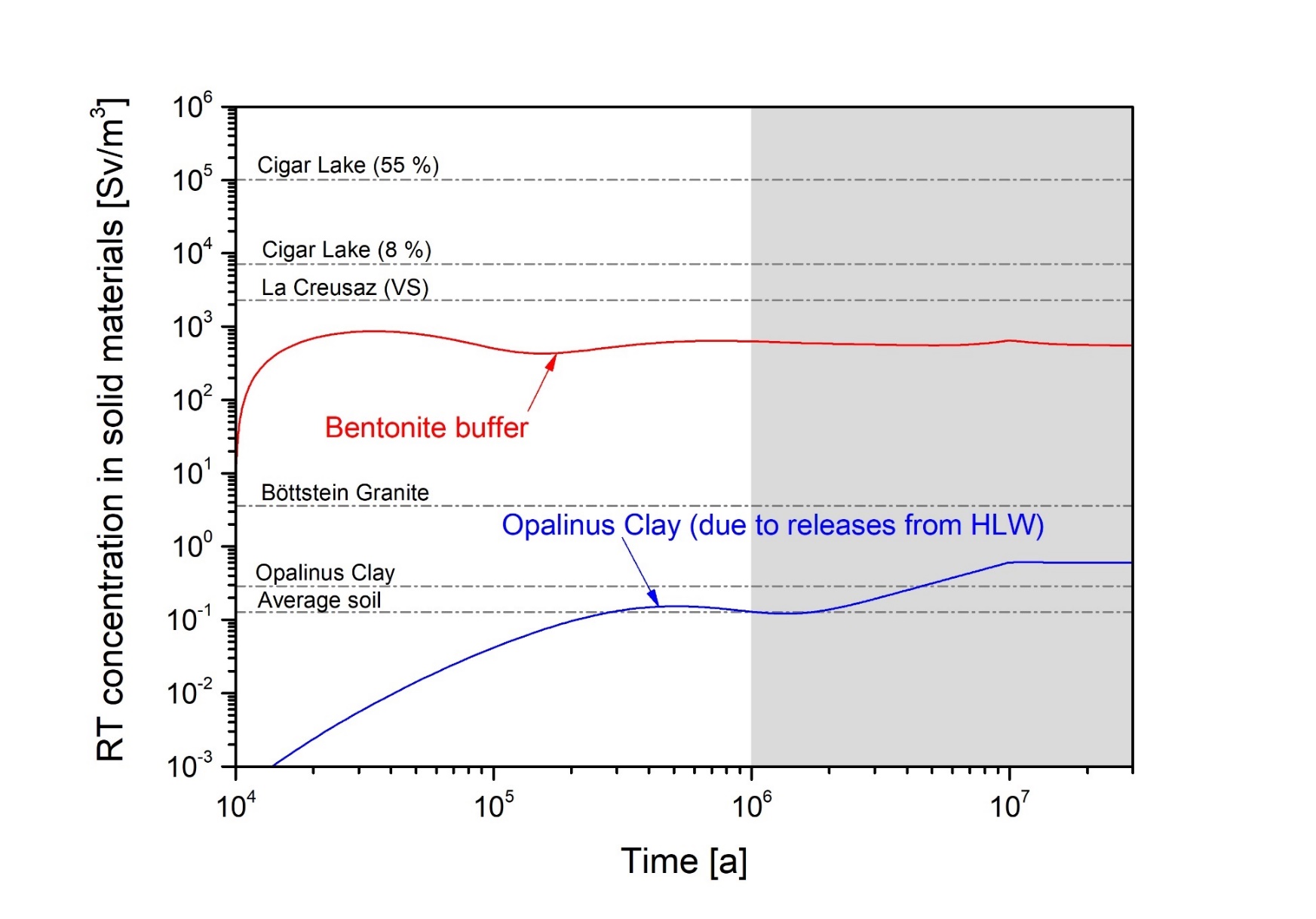
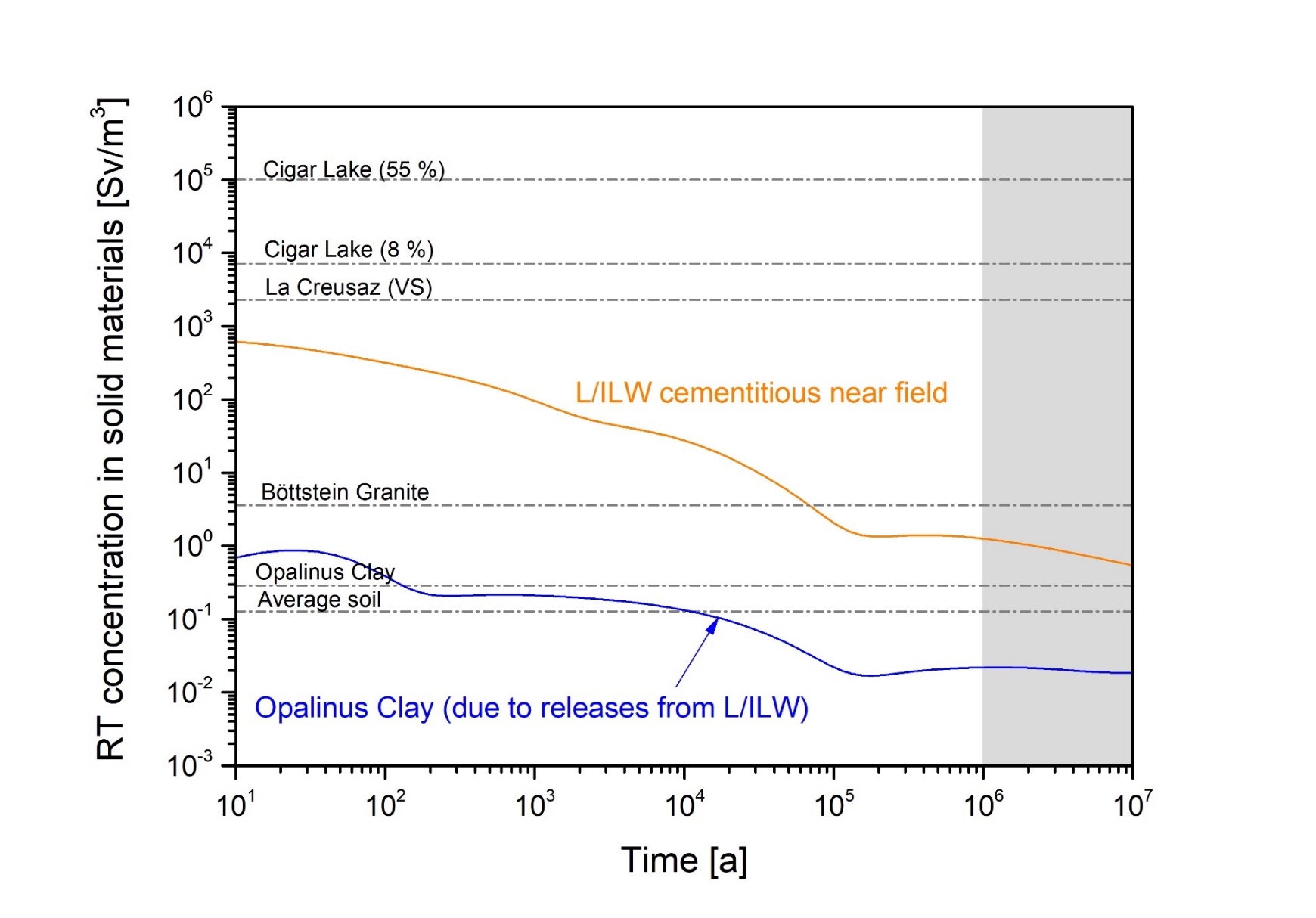
Fig. 9‑9:Reference case RT concentrations, sorbed and aqueous, in materials in the HLW bentonite buffer and in the L/ILW cementitious near field, as well as in the Opalinus Clay host rock, due to releases from HLW (upper figure) and from L/ILW (lower figure)
These concentrations are compared with the RT concentrations found naturally in various rocks and ores, including the Opalinus Clay, and in average soil.

